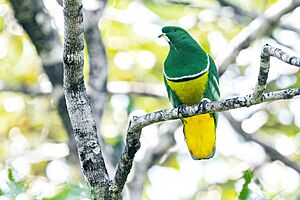Cloven-feathered dove facts for kids
Quick facts for kids Cloven-feathered dove |
|
|---|---|
 |
|
| Conservation status | |
| Scientific classification | |
| Genus: |
Drepanoptila
|
| Species: |
holosericea
|
The cloven-feathered dove (Drepanoptila holosericea) is a beautiful bird. It belongs to the Columbidae family, which includes all doves and pigeons. This special dove is the only member of its genus called Drepanoptila.
You can only find the cloven-feathered dove in New Caledonia, an island nation in the Pacific Ocean. It lives in forests and a type of grassland called Melaleuca savanna. These birds can be found at heights up to 1,000 meters (about 3,300 feet) above sea level.
The IUCN (International Union for Conservation of Nature) considers this dove to be near-threatened. This means it might become endangered in the future. Its population is shrinking because its home is being damaged and because of hunting.
Where the Cloven-feathered Dove Lives
The cloven-feathered dove lives only on the island of New Caledonia. It is often seen in the island's forests. You can also find it on a smaller island south of New Caledonia called Ile des Pins. However, it does not live on the nearby Loyalty Islands.
Scientists studied these birds in 1998. They estimated that about 140,000 cloven-feathered doves live across their entire home range.
What the Dove Does and Eats
The cloven-feathered dove usually lives in moist forests. These can be either old, untouched forests (called primary) or forests that have grown back after being disturbed (called secondary). They live at elevations up to 1,000 meters.
These doves seem to like humid forests best. They often prefer areas between 400 and 600 meters high. They especially like the edges of these forests.
Scientists don't know much about what the cloven-feathered dove eats. But ornithologists, who are bird experts, have seen them eating different kinds of fruits and berries.
Dangers to the Cloven-feathered Dove
Hunting is a small threat to this bird right now. This is because hunters have limits on how much ammunition they can use. They often save their bullets for bigger animals.
However, if these limits were removed, more doves might be hunted. This could cause their numbers to drop quickly. Even though the cloven-feathered dove is protected by law, it still faces dangers.
Other big threats to these birds include:
- Forest fires, which destroy their homes.
- Deforestation, which is when forests are cut down.
- Mining operations, which also destroy their habitat.


